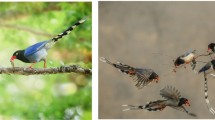Abstract
When unmanned aerial vehicles (UAVs) track a moving target in complex environment, most path planning methods are difficult to combine real-time calculation and optimality. A real-time path planning method based on boundary value problem (BVP) is studied. First, a grid model of terrain is established based on UAV constraints. Then the structure of receding horizon planning ensures the real-time tracking to moving target, and the path is determined based on BVP in each horizon window. The sub-goal of horizon window is designed by line-of-sight, and the method of updating potential field dynamically and the calculation of flight direction are proposed. By comparison with other methods, the simulation results show that the method can ensure the path smooth and feasible. It can track the moving target in real-time and have some optimality, which is suitable for the mission of UAV to track moving target in complex environment.











Similar content being viewed by others
References
Chen, X., Chen, X., Xu, G.: The path planning algorithm studying about UAV attacks multiple moving targets based on Voronoi diagram. Int. J. Control Autom. 9(1), 281–292 (2016)
Marco, C.C., Victor, A.R., Uriel, H.B.: Mobile robot path planning using artificial bee colony and evolutionary programming. Appl. Soft Comput. 30(2015), 319–328 (2015)
Su, P., Li, Y., Li, Y., Shiu, S.: An auto-adaptive convex map generating path-finding algorithm: genetic convex A*. Int. J. Mach. Learn. Cybern. 4(5), 551–563 (2013)
Zhao, J., Liu, W.: Study on dynamic routing planning A-star algorithm based on cooperative vehicles infrastructure technology. J. Comput. Inf. Syst. 11(12), 4283–4292 (2015)
Hamed, S., Mojtaba, V., Babak, I., Ali, G.: Optimal cooperative path planning of unmanned aerial vehicles by a parallel genetic algorithm. Robotica 34(4), 823–836 (2016)
Andrei, L., Carsten, W.: Runtime analysis of ant colony optimization on dynamic shortest path problems. Theor. Comput. Sci. 561, 73–85 (2015)
Cai, Y., Yang, S.: A PSO-based approach with fuzzy obstacle avoidance for cooperative multi-robots in unknown environments. Int. J. Comput. Intell. Appl. 15(1), 1386–1391 (2016)
De Ruiter, A.H.J., Owlia, S.: Autonomous obstacle avoidance for fixed-wing unmanned aerial vehicles. Aeronaut. J. 119(1221), 1415–1436 (2015)
Jerin, L., Saravana, S., Ponnambalam, S.G.: An elitist strategy genetic algorithm using simulated annealing algorithm as local search for facility layout design. Int. J. Adv. Manuf. Technol. 84(5–8), 787–799 (2016)
Oscar, M., Roberto, S., Ulises, O.: Optimal path planning generation for mobile robots using parallel evolutionary artificial potential field. J. Intell. Robot. Syst. 79(2), 237–257 (2015)
Luo, G., Yu, J., Mei, Y., Zhang, S.: UAV path planning in mixed-obstacle environment via artificial potential field method improved by additional control force. Asian J. Control 17(5), 1600–1610 (2015)
Waydo, S., Murray, R.H.: Vehicle motion planning using stream functions. In: Proceedings 2003 IEEE Inter-national Conference on Robotics and Automation, Taipei, Taiwan, China, 14–19 September 2003, pp. 2484–2491. (2003)
Daily, R., Bevly, D.M.: Harmonic potential field path planning for high speed vehicles. In: Proceedings 2008 American Control Conference, Piscataway, New Jersey, USA, 11–13 June 2008 pp. 4609–4614. (2008)
Liang, X., Wang, H., Li, D., Liu, C.: Three-dimensional path planning for unmanned aerial vehicles based on principles of stream avoiding obstacles. Hangkong Xuebao/acta Aeronautica Et Astronautica Sin. 34(7), 1670–1681 (2013)
Giuseppe, F., Walter, L.: A receding horizon control strategy for autonomous vehicles in dynamic environments. IEEE Trans. Control Syst. Technol. 24(2), 695–702 (2016)
Tanzmeister, G., Wollherr, D., Buss, M.: Grid-based multi-road-course estimation using motion planning. IEEE Trans. Veh. Technol. 65(4), 1924–1935 (2016)
Breitenmoser, A., Siegwart, R.: Surface reconstruction and path planning for industrial inspection with a climbing robot. In: 2012 2nd International Conference on Applied Robotics for the Power Industry (CARPI), Zurich, Switzerland, 11–13 September 2012, pp. 22–27. (2012)
Nieuwenhuisen, M., Steffens, R., Behnke, S.: Local multiresolution path planning in soccer games based on projected intentions. RoboCup 2011 7416, 495–506 (2012)
Connolly, C.I., Grupen, R.A.: On the application of harmonic functions to robotics. J. Robot. Syst. 10(7), 931–946 (1993)
Silveira, R., Dapper, F., Prestes, E., Nedel, L.: Natural steering behaviors for virtual pedestrians. Vis. Comput. 26(9), 1183–1199 (2010)
Ekta, S., Bhaskar, D.: Maneuvering redundant manipulators in cluttered environments. In: Proceedings 2013 6th Robotics and Mechatronics Conference, Durban, South Africa, 30–31 October 2013 pp. 20–25. (2013)
Liang, X., Wang, H., Cao, M., Guo, T.: Real-time path planning to track moving target in complex environments for UAV. J. Beijing Univ. Aeronaut. Astronaut. 38(9), 1129–1133 (2012)
Lee, J., Kim, D.: An effective initialization method for genetic algorithm-based robot path planning using a directed acyclic graph. Inf. Sci. 332(2016), 1–18 (2016)
Acknowledgments
This work is supported by National Natural Science Foundation of China under Grant 61503255 and Natural Science Foundation of Liaoning Province under Grant 2015020063. The authors also gratefully acknowledge the helpful comments and suggestions of the reviewers, which have improved the presentation. The authors declare that there is no conflict of interest regarding the publication of this article.
Author information
Authors and Affiliations
Corresponding author
Rights and permissions
About this article
Cite this article
Liang, X., Meng, G., Luo, H. et al. Dynamic path planning based on improved boundary value problem for unmanned aerial vehicle. Cluster Comput 19, 2087–2096 (2016). https://doi.org/10.1007/s10586-016-0650-1
Received:
Revised:
Accepted:
Published:
Issue Date:
DOI: https://doi.org/10.1007/s10586-016-0650-1




